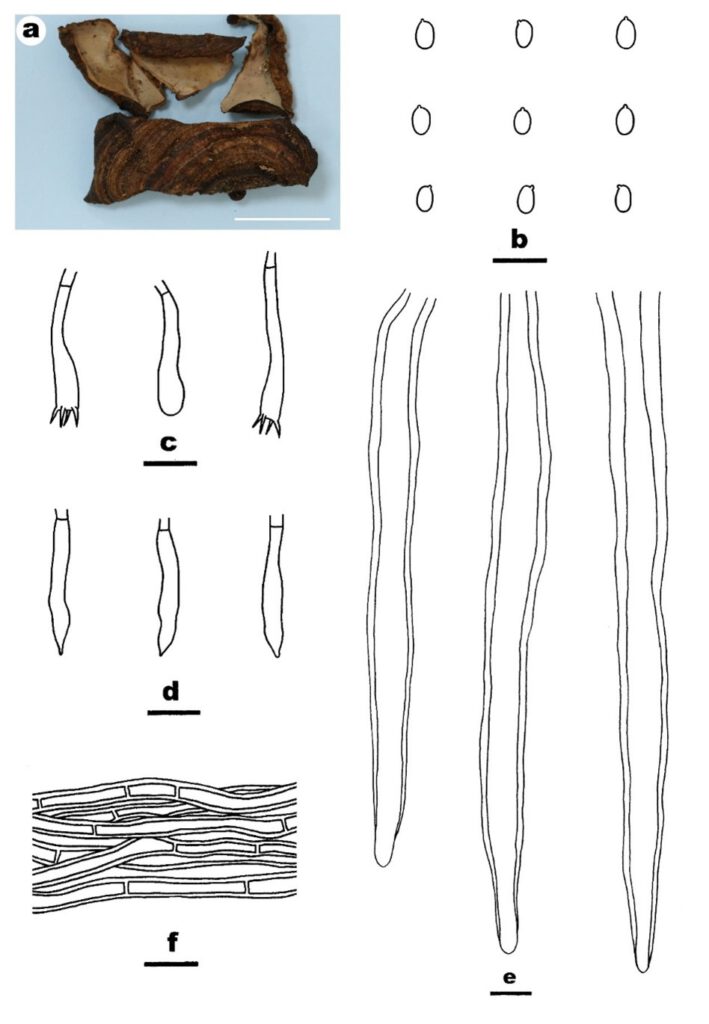Stereum vietnamensis S.H. He & Y.F. Cao, sp. nov.
MycoBank number: MB; Index Fungorum number: IF; Facesoffungi number: FoF 10789;
Description
Sexual state:Fruiting body – Basidiomata annual, effused-reflexed to distinctly pileate, dimidiate, imbricate, easily detached from substrate, soft corky to woody hard, projecting up to 4 cm long, 2 cm wide, 2 mm thick at base, incurved after dry. Pileal surface tomentose to hirsute when juvenile, becoming glabrous with age, light brown to dark brown, distinctly concentrically zonate and sulcate; margin distinct, sharp. Hymenophore smooth to tuberculate, light orange [5A(4–5)], greyish orange [5B(3–4)] to brownish orange [5C(3–4)], slightly darkening in KOH, uncracked; margin indistinct, concolorous with hymenophore. Context cream to light brown, up to 0.8 mm thick.
Microscopic structures – Hyphal system monomitic; all hyphae without clamps. Cortex (a dark line between tomentum and subiculum) present, dark brown, composed of densely interwoven and agglutinated hyphae. Subiculum well-developed, thick, with a compact texture, with hyphae agglutinated and parallel to substrate; generative hyphae colorless to pale yellow, thick-walled, smooth, rarely branched, frequently septate, 2.5–4 µm in diam. Skeletal hyphae pale yellow, distinctly thick-walled, smooth, unbranched, without septa, 3–5 µm in diam. Subhymenium thickening; generative hyphae colorless, slightly thick-walled, smooth, slightly agglutinated, vertically arranged, 2–3.5 µm in diam. Skeletocystidia colorless to pale yellow, thick-walled, tubular to subulate, with a thin-walled and tapered apex, arising from subhymenium, embedded, up to 250 µm long, 16 µm wide. Acutocystidia numerous, colorless, thin-walled, smooth. Basidia clavate, colorless, thin-walled, smooth, with four sterigmata and a basal simple septum, 18–28 ´ 4–5 µm; basidioles numerous, in shape similar to basidia, but slightly smaller. Basidiospores ellipsoid to ovoid, colorless, thin-walled, smooth, amyloid, acyanophilous, 4.5–5 ´ 2.5–3.2 µm, L = 4.8 µm, W = 3 µm,Q = 1.6 (n = 30/1).
Asexual state: not observed.
Material examined: VIETNAM, Lam Dong Province, Bi Doup Nui Ba National Park, on fallen angiosperm trunk, 15 October 2017, He 5248 (BJFC 024766, holotype, isotype in BJM).
Distribution: Vietnam
Sequence data: LSU: MW528939 (LROR/LR7)
Notes: Stereum vietnamensis is characterized by the hard basidiomata with a brown pileal surface, large skeletocystidia and small basidiospores. Stereum gausapatum (Fr.) Fr. is similar to S. vietnamensis by sharing the hard basidiomata with a brown pileal surface but differs in having larger cylindrical basidiospores (6–10 ´3.5–4.5 µm, Bernicchia and Gorjón 2010). Macroscopically, S. vietnamensis resembles Xylobolus princeps (Jungh.) Boidin, which however, differs in having larger basidiomata and numerous acanthocystidia (Ryvarden 2012).

Fig. 10. Stereum vietnamensis (BJFC 024766, holotype). a Basidiomata. b Basidiospores. c Basidia and a basidiole. d Acutocystidia. e Gloeocystidia. f. Generative hyphae from subiculum. Scale bars: a = 1 cm, b–f = 10 µm.
